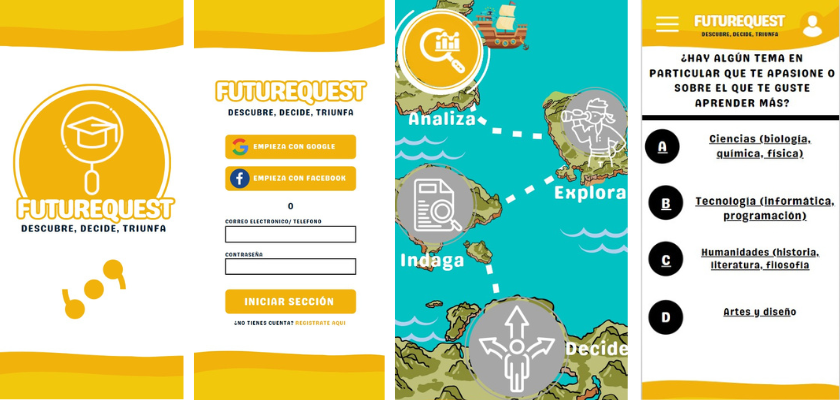To choose a career as a teenager can be a big challenge. You’re still discovering yourself and may not know much about the job market or the curriculum of each major. Many young people face the pressure of deciding for their future without being clear about their passions and skills. Three students from Colombia noticed that their classmates who were already finishing high school were going through this dilemma and facing anxiety as a result. So they thought: what if we used our programming knowledge to help them somehow in this process?
This was the central question to make born the winner of Solve for Tomorrow in the country in 2023: the STEM project “Futurequest: Descubre, Decide, Triunfa” (Futurequest: Discover, Decide, Succeed, in English). It proposes an application that performs a vocational test to indicate which careers best fit the student’s profile and tell them where they can study in Colombia.
The youngs involved were 15 years old and were in the 9th grade of secondary education (the penultimate year of compulsory schooling) at the El Castillo Educational Institution. They were accompanied by the mediator teacher Elliot Amaya, who teaches Information Technology and works on programming and computational thinking in preschool. “I start working with them on Design Thinking and we do exercises to come up with project proposals. I review until I evaluate that they can now register for calls for proposals such as the Solve for Tomorrow’s one,” he explains. They also learn about Research Methodology, so they are already more accustomed to project-based learning.
Identifying problems in the school itself
During classes, in an exercise of empathy, it was observed that 11th-grade students had difficulty to choose a career deciding what they were going to study at university. “They saw that very few of them were clear about what to do after finishing high school and that caused anxiety symptoms,” Amaya reports.
Having programming skills, they thought of creating an app to help with the decision. “First, the tool makes a diagnosis of the student’s preferences and then gives suggestions for careers based on that,” he describes. Among the questions it asks are: “Is there a particular subject that you are passionate about or that you would like to learn more about” and “What activity do you enjoy most in your free time?”

In addition, the application differs from general tests available on the Internet to choose a career because it already shows which universities in Colombia have the recommended courses and indicates whether they are public or private, and which ones offer scholarships. “It is a much more personalized diagnosis compared to others and the student can have a more solid basis to be able to decide,” says the teacher.
To apply for Solve for Tomorrow, they could only submit an essay with the proposal, without images or videos. Then, they had to translate the idea into text. “When they have to tell a story, I work a lot with the Storyboard, in which they narrate the idea through images. That helped them a lot to organize their ideas before writing,” adds the educator.
Step by step to create the application
Once the plan was perfected, they needed to have a database of the courses available in the country. The students manually listed all the options from public and private universities in Colombia. “Compiling the information needed is the most complicated part of the project because it has to be up to date,” says the teacher.
So, they had to choose the questions to ask the students. To do this, they had the help of the school’s psycho-guidance department. “I remember when I was in high school there was a subject called vocational guidance and now it doesn’t exist. But with the school’s department, they managed to understand how that guideline works and the best way to adapt it to the application,” he emphasizes.
At the beginning, the group was very reluctant to make changes, but they learned that it is important to do so and not leave things as they were. It is important to try different methods and in programming, trial and error is always used, concludes the educator.
The team aims to take the project to the final product
The prototype works as a simulation of what the application would be like and all the development was done with free tools available online. For the design, they used the Canva platform. They also used MIT App Inventor, to create applications that can be integrated into Android or iOS mobiles.
The model was tested with 11th-grade students and recent school leavers. “They liked it a lot and gave suggestions on what could be improved, such as the interaction with some options,” recalls the teacher.
Following the success of Solve for Tomorrow in 2023, the educator noticed that more teachers and students were motivated to propose projects for this type of initiative. In 2024, several teams participated. Furthermore, according to Amaya, the Futurequest team intends to continue working with the prototype until reaching a final result: a ready-to-use application.



